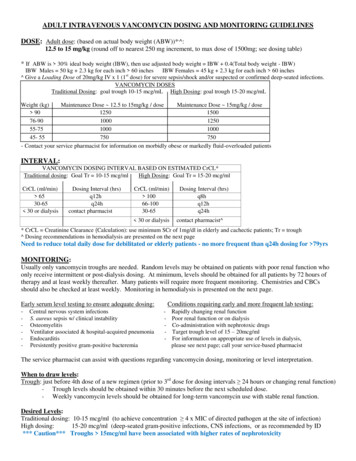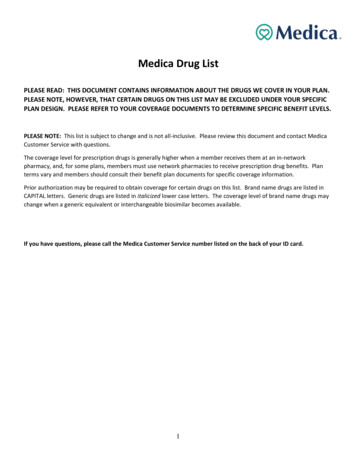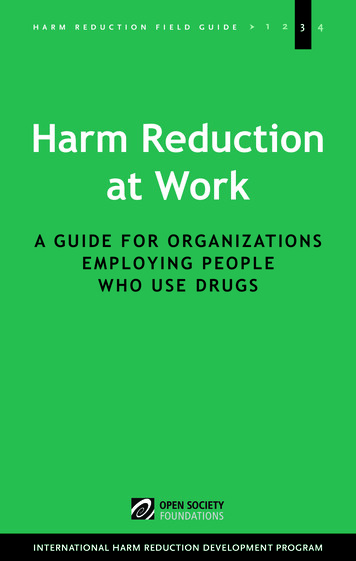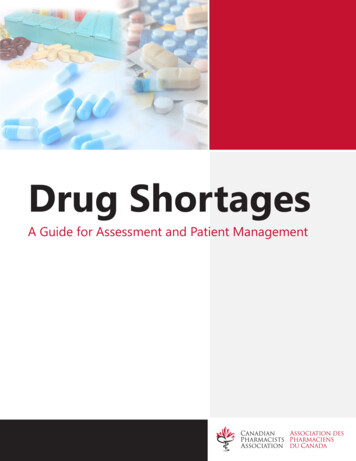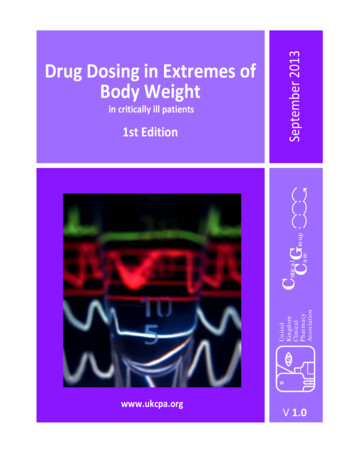
Transcription
in critically ill nCriticalCGroup1st EditionSeptember 2013Drug Dosing in Extremes ofBody Weightwww.ukcpa.orgV 1.0
UKCPA:Drug Dosing in Extremes of Body Weight in critically ill patientsst1 Edition (v1.0)September 3Background4Drug Dosing macyAssociationCriticalCareGroupPage 1
UKCPA:Drug Dosing in Extremes of Body Weight in critically ill patientsst1 Edition (v1.0)September 2013Introduction to 1st edition (2013)Obesity is becoming increasingly prevalent in the western world and consequently morecommon in critically ill patients. However, the dosing information for most drugs is generallyobtained from studies carried out on “average weight” patients so may not be relevant topatients at the extremes of bodyweight. Yet for critically ill patients, it may be especiallyimportant to administer an optimal dose of a drug to ensure therapeutic levels are obtained.This document which represents information and experience of dosing of drugs in critically illpatients in extremes of body weight, has been produced by the Scottish Adult Critical CarePharmacists Network (SACCPN) in an attempt to make the necessary information more readilyavailable.The information provided is supported by collation of the limited literature available in thisarea, and by anecdotal experience of pharmacists working within critical care in Scotland. Thisdocument is intended to provide information on dosing in extremes of body weight, to allowpractitioners to make informed decisions. The document does not provide a substitute forclinical judgement, and the authors trust that the information provided will only be used as partof the clinical decision making process. Every effort has been made to ensure that theinformation contained in this document is accurate and up to date, however no liability can beaccepted for any inaccuracies or misstatements of fact contained herein, nor for any patient orclinical outcomes which may occur as a result of referring to information contained within thisdocument. It is expected that this document will continue to evolve but as a start we haveincluded some of the commonly used medicines used within critical care areas. It is hoped toinclude more monographs in future editions.We hope that you will find the document useful and feedback is welcome. Please send any newinformation or experiences for inclusion in future editions to either Keith Addie(keith.addie@ggc.scot.nhs.uk) or Alan Timmins (alan.timmins@nhs.net) so that the informationcontained in the document can be kept up to date and relevant to clinical practice.Many ThanksKeith AddieSenior Clinical PharmacistVictoria Infirmary, GlasgowOn behalf of the Scottish Adult Critical Care Pharmacists NetworkN.B. Information provided does not provide a substitute for clinical judgement.No liability can be accepted for any inaccuracies or misstatements of fact contained herein, nor for any patient or clinicaloutcomes which may occur as a result of referring to information contained within this riticalCareGroupPage 2
UKCPA:Drug Dosing in Extremes of Body Weight in critically ill patientsst1 Edition (v1.0)September 2013AcknowledgmentsWorking GroupKeith Addie, Senior Pharmacist, Victoria Infirmary, GlasgowAlison Bell, Senior Pharmacist, Dumfries and Galloway Royal InfirmaryMartyn Gall, Senior Pharmacist Southern General Hospital, GlasgowMorag Naysmith, Senior Pharmacist Western General Hospital EdinburghAlan Timmins, Principal Pharmacist, Victoria Hospital KirkcaldyWe would like to acknowledge the contribution of the following pharmacists to the production of thisdocument:Morna Ball of Glasgow Royal InfirmaryJoanne Berrich of Inverclyde Royal Hospital, GreenockPeter Buckner of Forth Valley Royal Hospital, LarbertAlison Carruthers of Borders General Hospital, MelroseRuth Forrest of the Western Infirmary, GlasgowSusan Hughes of Crosshouse Hospital, KilmarnockDiane Kennedy of Ayr HospitalRakesh Kishore of Glasgow Royal InfirmaryPamela MacTavish of Glasgow Royal InfirmaryClaire McMaster of the Golden Jubilee National Hospital, ClydebankFiona MacGregor of the Royal Alexandra Hospital, PaisleyJennifer Murphy of Wishaw General HospitalFiona McIntyre of Ninewells Hospital, DundeePatricia Nicholas of the Golden Jubilee National Hospital, ClydebankN.B. Information provided does not provide a substitute for clinical judgement.No liability can be accepted for any inaccuracies or misstatements of fact contained herein, nor for any patient or clinicaloutcomes which may occur as a result of referring to information contained within this riticalCareGroupPage 3
UKCPA:Drug Dosing in Extremes of Body Weight in critically ill patientsst1 Edition (v1.0)September 2013BackgroundThere is little information about dosing adjustments in significantly underweight patients. Thereare some pieces of information in the guidance document. Some guidance may be obtainedfrom considering dosing in children, however it is important to remember that metabolism islikely to be considerably different in children. Obesity may have no effect on morbidity andmortality in ICU1 or may increase it2 The latter paper provides a review of the effects of obesityon metabolism and on drug handling, as does the one by Janson and Thursky3.Weights used in DosingThe following methods have been used to adjust dosing in obesityDescriptorAbbreviationFormulaTotal Body WeightTBWWeight (Wt)Actual Body WeightABWWeight (Wt)Body Mass IndexBMIWt/ height (m)2Ideal Body WeightIBW 45.4 [0.89 x (height {cm} – 152.4)] ( 4.5 if male)Excess Body WeightEBW TBW – IBWMaximum Body WeightMBW IBW 20%Adjusted Body WeightAdjBW IBW [DWCF*x EBW]Lean Body WeightLBWMale [9270 x TBW] / [6680 (216 x BMI)]Female [9270 x TBW] / 8780 (244 x BMI)]Fat Free MassFFMMale [TBW x 0.285] [12.1 x height(m)2]Female [TBW x 0.287] [9.74 x height(m)2]Predicted Normal WeightPNWMale [TBW x 1.57] – [TBW x BMI x 0.0183] – 10.5Female [TBW x 1.75] – [TBW x BMI x 0.0242] – 12.6Body Surface AreaBSA [(height{cm} x TBW)/ 3600]*DWCF Dose Weight Correction Factor (see below)N.B. Information provided does not provide a substitute for clinical judgement.No liability can be accepted for any inaccuracies or misstatements of fact contained herein, nor for any patient or clinicaloutcomes which may occur as a result of referring to information contained within this riticalCareGroupPage 4
UKCPA:Drug Dosing in Extremes of Body Weight in critically ill patientsst1 Edition (v1.0)September 2013Total Body Weight (TBW) is the weight as measured. This is sometimes referred to as the ActualBody Weight (ABW), which can cause confusion with the Adjusted Body Weight (AdjBW). BodyMass Index (BMI) is rarely used for dosing, but gives an indication of the patient’s stature. TheIdeal Body Weight (IBW) is obtained from statistical tables relating to life expectancy, and sohas little direct connection to pharmacokinetic parameters, but it is commonly used in doseadjustment. Maximum Body Weight (MBW) is a related term that is similarly approximate.When using IBW, there is an assumption that the Excess Body Weight (EBW) has no influenceon drug handling. However the adipose tissue does have some vasculature and some fluid, andin fact will usually have some influence. This can be accounted for by the Dose WeightCorrection Factor. Accurate values for the factor are not easily obtained, but a value of 0.4 isoften assumed. This value has been found to be useful with water‐soluble drugs, particularlyaminoglycosides.Lean Body Weight (LBW), Fat Free Mass and Predicted Normal Weight take into account thegender, height and weight (e.g. tall thin people or muscular people) to estimate the fractionalfat mass, so are in theory are good models for drugs that are highly hydrophilic. However theyare not widely used in practice, and are more often seen in a research context with specificdrugs. Body Surface Area is mainly used in cancer chemotherapy.Much of the work relating to the above equations was carried out on previous generations,when there were fewer subjects in the upper extremities of the weight range than in thepresent day, and there is very little validation for the use of any of these descriptors for drugdosing. Modified weights used in altering drug doses may not be applicable for assessingventilatory parameters, haemofiltration or nutritional requirements, and vice versa.Pharmacology/ kineticsDue to variable alterations in the volume of distribution, clearance and elimination half‐life inobesity dosing adjustments can be complex. In obese patients, the glomerular filtration rate(GFR) may be increased relative to a “normal” patient, so in theory drug clearance may beincreased. However complications of obesity, including diabetes and hypertension, may reduceclearance, so may negate this. Calculation of creatinine clearance using the Cockcroft & Gaultmethod in obese patients should use lean body weight (or maximum body weight), sincemuscle mass is proportionately much less in obese patients.N.B. Information provided does not provide a substitute for clinical judgement.No liability can be accepted for any inaccuracies or misstatements of fact contained herein, nor for any patient or clinicaloutcomes which may occur as a result of referring to information contained within this riticalCareGroupPage 5
UKCPA:Drug Dosing in Extremes of Body Weight in critically ill patientsst1 Edition (v1.0)September 2013An increased proportion of adipose tissue compared with lean tissue alters the volume ofdistribution of lipophilic drugs, TBW should generally therefore be used for dosing. Forhydrophilic drugs dosing relates better to lean body mass (i.e. IBW), though as noted abovethere is some extra water/ blood supply to excess tissue, so an adjustment factor is sometimesadded to give adjusted body weight.As there remains a lack of good information, careful monitoring of effect and side effects ismandatory in any patients where it is suspected normal parameters may not apply.References1. Akinnusi ME, Pineda LA, El Sohl AA . Effect of obesity on critical care morbidity and mortality: ameta‐analysis. Critical Care Medicine, 2008; 36: p151‐1582. Pieracci FM, Barie PS, Pomp A Critical care of the bariatric patient. Critical Care Medicine. 2006;34: p1796‐18043. Janson B, Thursky K. Dosing of antibiotics in obesity. Current Opinions in Infectious Diseases, 25;(6) p634 ‐ 649N.B. Information provided does not provide a substitute for clinical judgement.No liability can be accepted for any inaccuracies or misstatements of fact contained herein, nor for any patient or clinicaloutcomes which may occur as a result of referring to information contained within this riticalCareGroupPage 6
UKCPA:Drug Dosing in Extremes of Body Weight in critically ill patientsst1 Edition (v1.0)September 2013Drug Dosing InformationAciclovirSummary of product characteristics (SPC)1 Dosage in adults: 5mg/kg every 8 hours or 10mg/kg in immunocompromised patients orherpes encephalitis. 1Half‐life is dependent on renal function.Dose adjustments for renal impairment as per SPC or refer to renal drug handbook.2Summary of SACCPN literature review and literature from manufacturerUnderweight patientsNo data available on any dose adjustment required in low body weightObese patientsLiterature describes acute kidney injury in obese patients where aciclovir dose was based on actual bodyweight.3Summary/CommentsUnderweight patientsNo information availableObese patientsCalculate dose using Ideal Body Weight in obese patients taking renal function into account.2,4References1. Zovirax (Aciclovir) GlaxoSmithKline Ltd. Summary of Product Characteristics, Accessed atwww.medicines.org.uk, 23rd November 20122. Ashley C (Ed) & Currie, A (Ed). The renal drug handbook. 3rd edition. Radcliffe publishing, Oxford.2009.3. Personal communication. GlaxoSmithKline Medicines Information department. Email received2nd January 20134. Antimicrobial dosing in obese patients. Clinical Infectious Diseases. 1997; 25:1;112‐118.N.B. Information provided does not provide a substitute for clinical judgement.No liability can be accepted for any inaccuracies or misstatements of fact contained herein, nor for any patient or clinicaloutcomes which may occur as a result of referring to information contained within this riticalCareGroupPage 7
UKCPA:Drug Dosing in Extremes of Body Weight in critically ill patientsst1 Edition (v1.0)September 2013Ambisome Summary of product characteristics (SPC)1 Therapy is usually instituted at a daily dose of 1.0 mg/kg of body weight, and increased stepwiseto 3.0 mg/kg, as required.No dose adjustment recommended for renal impairment.1Summary of SACCPN literature review and literature from manufacturerUnderweight patientsDose as per SPC on mg/kg basis.Obese patientsGilead are about to commence a pharmacokinetic study in the obese population but until data isavailable from this the manufacturer recommends that all patients are dosed on a mg/kg basis. Patientsin the clinical studies ranged from very low birth weight neonates to adults 80kg but there is currentlyno data available from manufacturer in obese patients.2There is a single case report of an obese patient with nonmeningeal cryptococcal infection successfullytreated with amphotericin B plus flucytosine, followed by oral fluconazole. The dose of amphotericinwas based on actual body weight; levels were not determined, the dose of flucytosine was based onIBW, and serum levels were maintained within the desired therapeutic range, without t patientsDose as per SPC on a mg/kg basis.Obese patientsManufacturer recommends dosing on actual body weight, suggest monitoring for toxicity inobese patients.References1. Ambisome (Amphotericin) Gilead Sciences Ltd. Summary of Product Characteristics. Accessedat www.medicines.org.uk 19th July 2013N.B. Information provided does not provide a substitute for clinical judgement.No liability can be accepted for any inaccuracies or misstatements of fact contained herein, nor for any patient or clinicaloutcomes which may occur as a result of referring to information contained within this riticalCareGroupPage 8
UKCPA:Drug Dosing in Extremes of Body Weight in critically ill patientsst1 Edition (v1.0)September 20132. Personal correspondence with Gilead Medical Information 11th July 20133. Wurtz R, Itozaku G, Rodvold K. Antimicrobial Dosing in Obese patients. Clinical InfectiousDiseases 1997;25:112‐8.4. Gillum JG, Johnson M, Lavoie S et al. Pharmacotherapy 1995;15:251‐3.N.B. Information provided does not provide a substitute for clinical judgement.No liability can be accepted for any inaccuracies or misstatements of fact contained herein, nor for any patient or clinicaloutcomes which may occur as a result of referring to information contained within this riticalCareGroupPage 9
UKCPA:Drug Dosing in Extremes of Body Weight in critically ill patientsst1 Edition (v1.0)September 2013AnidulafunginSummary of product characteristics (SPC)1A single 200 mg loading dose should be administered on Day 1, followed by 100 mg daily thereafter.1Summary of SACCPN literature review and literature from manufacturerPfizer does not recommend adjusting the dose of anidulafungin based on body weight in adult patients.Phase 3 data showed weight in anidulafungin group ranged from 35 kg to 196.5kg.2Underweight patientsNo specific information available.Obese patientsLui et al conducted a post‐hoc pharmacokinetic analysis of a phase 3 study conducted in ICU patients. Allpatients received a 200mg loading dose on Day 1 followed by 100mg maintenance dose daily, with theexception of one 240kg patient who was given a 150mg daily maintenance dose. The higher dose was atthe discretion of the principal investigator in order to ensure sufficiently high exposure to anidulafungin.The patient had global treatment success. This patient was excluded from the summary statistics.2 Summary/CommentsUnderweight patientsNo change to manufacturer’s recommended dosageObese patientsNo change to manufacturer’s recommended dosageReferences1. Ecalta (Anidulafungin) Pfizer. Summary of Product Characteristics Accessed atwww.medicines.org.uk 12th July 20132. Lui P et al Pharmacokinetics of anidulafungin in adult intensive care patients. Mycoses 54(Suppl S2):75/121.N.B. Information provided does not provide a substitute for clinical judgement.No liability can be accepted for any inaccuracies or misstatements of fact contained herein, nor for any patient or clinicaloutcomes which may occur as a result of referring to information contained within this riticalCareGroupPage 10
UKCPA:Drug Dosing in Extremes of Body Weight in critically ill patientsst1 Edition (v1.0)September 2013BenzylpenicillinSummary of product characteristics (SPC)1 600mg to 3600mg daily, divided into 4‐6 doses depending on the indicationHigher doses as per SPC depending on indication.High dosage of benzylpenicllin sodium BP may result in hypernatraemia and hypokalaemiaunless the sodium content is taken into account.1Dose adjustments for renal impairment as per SPC or refer to renal drug handbook.2Summary of SACCPN literature review and literature from manufacturerUnderweight patientsNo specific information availableObese patientsOne review recommends that for penicillins dosing should be at the higher end of the recommendedtreatment ranges, particularly for morbidly obese patients with more severe infections.3Wurz et al suggested the use of a correction formula 0.30(actual body weight‐ideal body weight) ideal body weight where dose was increased in proportion to the excess in body weight4.Hites et al attempted to validate the use of the formula by carrying out a therapeutic drug monitoringstudy in both obese and non obese patients to evaluate the effect of obesity on attainment oftherapeutic concentrations of beta lactam antibiotics5.In the obese population use of standard dosages of beta lactam antibiotics resulted in insufficient serumconcentrations in 32% of patients and overdosed serum concentrations in 25%.Continuous renal replacement therapy (CRRT) was identified as a risk factor for higher serumconcentrations. Dosage regimens based on the correction formula only slightly increased serum drugconcentrations but had no impact on adequacy of treatment.5Roberts et al assessed therapeutic drug monitoring of beta lactam antibiotics, assessed against a targetconcentration of trough concentrations of 4‐5x MIC, a pharmacodynamic target of 100%.674% of patient’s initial doses of beta lactam doses did not achieve steady state pharmacodynamicendpoints which are believed to be associated with maximal beta lactam activity.In 50 % of patients a dose increase was required to attain concentration targets whilst in 24% of patientsa dosage decrease was required.N.B. Information provided does not provide a substitute for clinical judgement.No liability can be accepted for any inaccuracies or misstatements of fact contained herein, nor for any patient or clinicaloutcomes which may occur as a result of referring to information contained within this riticalCareGroupPage 11
UKCPA:Drug Dosing in Extremes of Body Weight in critically ill patientsst1 Edition (v1.0)September 2013The aggressive pharmacodynamic targets chosen for this study appeared to have good clinical resultsand little observed toxicity, however lacked the statistically significant data on outcomes which couldonly be produced by a randomised clinical trial.6No information available from manufacturer.7Summary/CommentsUnderweight patientsNo information availableObese patientsDosing for penicillins, dosing should be at the upper end of the higher end of the recommendedtreatment ranges, particularly in morbidly obese patients with more severe infections.Suggest dosing at upper end of range where appropriate, taking into account patient’s renalfunction. Suggest discussing with local microbiology or infectious diseases.References1. Crystapen (Benzylpenicillin) Genus Pharmaceuticals. Summary of Product Characteristics Accessedat www.medicines.org.uk 8th February 20132. Ashley C (Ed), Currie A (Ed), The Renal Drug Handbook. 3rd edition. Radcliffe Publishing, Oxford 20093. Erstad B. Dosing of medications in morbidly obese patients in the intensive care unit setting.Intensive Care Medicine 2004; 30:18‐32.4. Wurz R, Itokazu G, Rodvold K. Antimicrobial Dosing in Obese Patients. Clinical Infectious Diseases.Clinical Infectious Diseases 1997; 25: 112‐8.5. Hites M, Taccone FS, Wolff F et al. Case‐Control study of Drug Monitoring of ß‐Lactams in ObeseCritically ill Patients. Antimicrobial Agents and Chemotherapy 2013;57(2):7086. Roberts JA, Ulldemolins M, Roberts MS et al. Therapeutic drug monitoring of ß‐Lactams in criticallyill patients: proof of concept. International Journal of Antimicrobial Agents 2010;36:332‐39.7. Genus Pharmaceuticals. Personal communication with medical information department. 7thFebruary 2013N.B. Information provided does not provide a substitute for clinical judgement.No liability can be accepted for any inaccuracies or misstatements of fact contained herein, nor for any patient or clinicaloutcomes which may occur as a result of referring to information contained within this riticalCareGroupPage 12
UKCPA:Drug Dosing in Extremes of Body Weight in critically ill patientsst1 Edition (v1.0)September 2013Ceftriaxone/CefalosporinsSummary of product characteristics Ceftriaxone (SPC)1 Standard therapeutic dosage: 1g once dailySevere Infections: 2‐4g daily, normally as a once daily dose.Dose adjustments for renal impairment or hepatic impairment as per SPC or refer to renaldrug handbook.2Summary of SACCPN literature review and literature from manufacturer3Underweight patientsNo informationObese patientsCeftriaxoneSuggest dosing at top end of licensed dose in obese patients for ceftriaxone/ cefalosporins taking intoaccount renal and hepatic function as above. (Licensed dose of ceftriaxone in severe infections 2‐4gdaily).Dose reduction/caution is necessary in patients with severe renal impairment accompanied by hepaticinsufficiency.1Two separate studies assessed distribution of cefalosporins given in obese male and female subjects.Additional Information ‐ CefalosporinsMann et al assessed subcutaneous adipose tissue concentrations of cefamandole in adult patients givenas surgical prophylaxis in operations lasting greater than 3 hours. Increased doses of cefamandole (2g 3hrly) necessary to maintain wound concentrations above MIC during surgery in morbidly obesepatients.4Yost et al assessed plasma levels after intravenous administration of cefotaxime in normal weight andmorbidly obese male and female subjects. Analysis of plasma levels showed no statistical significantdifference between the concentrations achieved in normal weight and morbidly obese subjects.5The above studies appear to suggest that as hydrophilic drugs, standard dosing of cefalosporins willachieve adequate plasma levels however higher than normal doses may be required to achieveadequate levels in subcutaneous adipose tissue which may be relevant when they are used as surgicalprophylaxis.N.B. Information provided does not provide a substitute for clinical judgement.No liability can be accepted for any inaccuracies or misstatements of fact contained herein, nor for any patient or clinicaloutcomes which may occur as a result of referring to information contained within this riticalCareGroupPage 13
UKCPA:Drug Dosing in Extremes of Body Weight in critically ill patientsst1 Edition (v1.0)September 2013Summary/CommentsUnderweight patientsNo informationObese patientsSuggest dosing at top end of licensed dose in obese patients for ceftriaxone/ cefalosporinstaking into account renal and hepatic function as above. (Licensed dose in severe infections 2‐4gdaily)Dose reduction/caution is necessary in patients with severe renal impairment accompanied byhepatic insufficiency.1References1. Rocephin Roche. Summary of Product Characteristics Accessed at www.medicines.org.uk accessed11th January 20132. Ashley C (Ed) & Currie, A (Ed). The renal drug handbook. 3rd edition. Radcliffe Publishing, Oxford.2009.3. Personal communication with Roche April 2013.4. Mann HJ, Buchwald H. Cefamandole distribution in serum, adipose tissue and wound drainage inmorbidly obese patients. Drug Intelligence and Clinical Pharmacy 1986;20:869‐873.5. Yorst RL, Derendorf H. Disposition of Cefotaxime and its Desacetyl Metabolite in Morbidly ObeseMale and Female Subjects. Therapeutic Drug Monitoring1986;8:189‐194.N.B. Information provided does not provide a substitute for clinical judgement.No liability can be accepted for any inaccuracies or misstatements of fact contained herein, nor for any patient or clinicaloutcomes which may occur as a result of referring to information contained within this riticalCareGroupPage 14
UKCPA:Drug Dosing in Extremes of Body Weight in critically ill patientsst1 Edition (v1.0)September 2013CiprofloxacinSummary of product characteristics (SPC)1 By intravenous infusion 400mg every 8‐12 hoursNo advice on underweight or obese patientsDose adjustments for renal impairment or hepatic impairment as per SPC/renal drug handbookas relevant.2Summary of SACCPN literature review and literature from manufacturer3Underweight patientsNo information on underweight patients however, mg/kg dosing can be used.Obese patientsInformation from manufacturer:The manufacturer provides no specific advice. However, they provide a number of referencesAllard et al suggest using a weight adjusted dose based onIdeal body weight 0.45(total body weight‐IBW)They also noted an increased total clearance in obese patients.4Van Zanten et al suggest that higher doses of ciprofloxacin should always be used either 600mg bd or400mg tds. Slight preference to 600mg bd as this achieves higher Cmax/MIC ratio.5Hollenstein et alsuggest that in obese patients, ciprofloxacin doses should be weight adjusted based on actual bodyweight in order to achieve the same tissue concentrations as those achieved in lean subjects althoughaccept that this may lead to an increased risk of adverse effect.6Summary/CommentsUnderweight patientsNo information on underweight patients however, mg/kg dosing can be used.Obese patientsObese patients may benefit from increased dosing and weight based doses have been suggestedusing IBW (0.45 x excess body weight) and 4 – 5 mg/kg/dose. It is also suggested that 600mgbd is better than 400mg tds as this improves (C max): MIC ratio.N.B. Information provided does not provide a substitute for clinical judgement.No liability can be accepted for any inaccuracies or misstatements of fact contained herein, nor for any patient or clinicaloutcomes which may occur as a result of referring to information contained within this riticalCareGroupPage 15
UKCPA:Drug Dosing in Extremes of Body Weight in critically ill patientsst1 Edition (v1.0)September 2013References1. Ciproxin Bayer. Summary of Product Characteristics Accessed at www.medicines.org.uk 11thJanuary 20132. Ashley C (Ed) & Currie, A (Ed). The renal drug handbook. 3rd edition. Radcliffe Publishing, Oxford.2009.3. Personal communication with Bayer 10th January 2013.4. Allard S et al. Intravenous ciprofloxacin disposition in obesity. Clin Pharmacol Ther 1993; 54 (4):368‐3735. Van Zanten ARH, et al. Ciprofloxacin pharmacokinetics in critically ill patients: A prospectivecohort study. J crit care 2008; 23, 422‐4306. Hollenstein UM et al. Soft tissue concentrations of ciprofloxacin in obese and lean subjectsfollowing weight‐adjusted dosing. Int J Obes 2001;25(3):354‐358N.B. Information provided does not provide a substitute for clinical judgement.No liability can be accepted for any inaccuracies or misstatements of fact contained herein, nor for any patient or clinicaloutcomes which may occur as a result of referring to information contained within this riticalCareGroupPage 16
UKCPA:Drug Dosing in Extremes of Body Weight in critically ill patientsst1 Edition (v1.0)September 2013ClarithromycinSummary of product characteristics (SPC)1 By intravenous infusion 500mg every 12 hoursNo advice on underweight or obese patientsSummary of SACCPN literature review and literature from manufacturer2Doses of 500mg twice daily, 1000mg twice daily and 2000mg twice daily were found to have comparableoverall effect however, the higher doses resulted in increased gastrointestinal side effects.3Underweight patientsNo information on dosing in underweight patients.Obese patientsNo information on dosing in obese patientsSummary/CommentsUnderweight patientsNo information on dosing in underweight patients
2. Pieracci FM, Barie PS, Pomp A Critical care of the bariatric patient. Critical Care Medicine. 2006 ;34: p1796‐1804 3. Jansonhursky B, T K. Dosing of antibiotics in obesity. Current Opinions in Infectious Diseases, 25; (6) p634 ‐ 649


